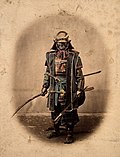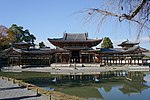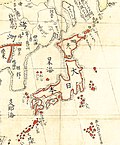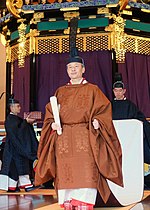The Azuchi Screens (Japanese: 安土屏風) are a set of six-folding screens depicting Azuchi Castle and its nearby town. Oda Nobunaga gifted them to Pope Gregory...
11 KB (1,111 words) - 13:48, 28 October 2024
Azuchi Castle (安土城, Azuchi-jō) was one of the primary castles of Oda Nobunaga located in the Azuchi neighborhood of the city of Ōmihachiman, Shiga Prefecture...
17 KB (1,800 words) - 23:36, 30 August 2024
The Azuchi–Momoyama period (安土桃山時代, Azuchi–Momoyama jidai) was the final phase of the Sengoku period (戦国時代, Sengoku jidai) in Japanese history from 1568...
29 KB (3,430 words) - 20:32, 4 October 2024
the now lost Azuchi Screens. The period in the history of Japan approximately between 1568 and 1603 is called Azuchi-Momoyama period. Azuchi Castle ruins...
2 KB (207 words) - 03:23, 17 April 2024
the so-called Azuchi Screens to Pope Gregory XIII, who displayed them in the Vatican. In the 17th and 18th centuries, many folding screens were imported...
17 KB (1,739 words) - 21:39, 29 July 2024
Note 53. McKelway, Matthew (2006). "The Azuchi Screens and Images of Castles". Capitalscapes Folding Screens and Political Imagination in Late Medieval...
20 KB (2,302 words) - 19:11, 10 November 2024
Oda Nobunaga (category People of Azuchi–Momoyama-period Japan)
Railways. McKelway, Matthew (2006). "The Azuchi Screens and Images of Castles". Capitalscapes Folding Screens and Political Imagination in Late Medieval...
172 KB (21,188 words) - 00:57, 9 November 2024
May 2014. McKelway, Matthew (2006). "The Azuchi Screens and Images of Castles". Capitalscapes Folding Screens and Political Imagination in Late Medieval...
5 KB (399 words) - 22:40, 8 April 2024
portable gilded chashitsu (tea room) constructed during the late 16th century Azuchi–Momoyama period for the Japanese regent Lord Toyotomi Hideyoshi's tea ceremonies...
16 KB (1,700 words) - 10:19, 31 August 2024
original on 2017-10-14. Retrieved 2017-10-14. "Folding Screens and Sliding Door Paintings: Azuchi-Momoyama–Edo period (May–July 2017)". Tokyo National Museum...
8 KB (627 words) - 02:30, 18 August 2024
Byōbu (redirect from Japanese screens)
were Japanese folding screens. The word byōbu entered Mexican Spanish as biombo. The scenes depicted on these folding screens were frequently historical...
15 KB (1,563 words) - 12:24, 29 October 2024
Kanō school (redirect from Cypress screen attributed to Kanō Eitoku)
between 100 painted screens as the approach to a flower party. That, unlike scrolls, sliding doors were by convention not signed, and screens only rarely, considerably...
23 KB (3,155 words) - 16:24, 2 March 2024
one of the great painters of the Azuchi–Momoyama period (1573-1603), and he is best known for his byōbu folding screens, such as Pine Trees and Pine Tree...
8 KB (875 words) - 17:39, 7 July 2024
Cypress Trees (redirect from Cypress Trees screen)
to the Azuchi–Momoyama period (1573–1615). Now in Tokyo National Museum, it has been designated a National Treasure. This Japanese folding screen was made...
5 KB (405 words) - 02:21, 6 November 2024
of Kōrin's Wind God and Thunder God screens that belonged to Hōitsu's family. The monumental two-sided byōbu screens became a symbol of the Rinpa tradition...
7 KB (546 words) - 02:28, 6 November 2024
Japanese architecture (section Azuchi-Momoyama period)
made of shōji screens that can be pushed open to join two rooms together, and then close them allowing more privacy. The shōji screens are made of paper...
91 KB (11,221 words) - 18:33, 14 October 2024
Samurai (section Azuchi–Momoyama period)
including pikemen, bowmen, musketeers and horsemen were samurai". During the Azuchi–Momoyama period (late Sengoku period), "samurai" often referred to wakatō...
133 KB (16,337 words) - 16:03, 4 November 2024
as Zao. Not long after the kidnapping, Zareth's plan becomes apparent as Azuchi castle - the dwelling of Zao - rises from the waters. Joe Yamato, an experienced...
2 KB (265 words) - 16:59, 21 October 2024
Motonobu (1476–1559) In sharp contrast to the previous Muromachi period, the Azuchi–Momoyama period was characterized by a grandiose polychrome style, with...
40 KB (5,082 words) - 04:14, 12 February 2024
16, 1543 – October 12, 1590) was a Japanese painter who lived during the Azuchi–Momoyama period of Japanese history and one of the most prominent patriarchs...
7 KB (759 words) - 22:47, 19 April 2024
final phase of the Sengoku period (The Age of Warring States), mainly the Azuchi–Momoyama period. It features reenactments of historical events and commentary...
14 KB (610 words) - 04:04, 27 March 2024
Śākyamuni coming out of the mountains. 15th-16th century. Nara National Museum Azuchi–Momoyama period saw the rise of the Kanō school (狩野派 Kanō-ha?) which is...
40 KB (5,259 words) - 13:27, 27 October 2024
Japanese art (section Azuchi-Momoyama art)
works, depicting a continuing landscape through the four seasons. In the Azuchi–Momoyama period (1573–1603), a succession of military leaders, such as Oda...
108 KB (14,063 words) - 22:10, 17 September 2024
icons and other objects were produced, Nanban byōbu (南蛮屏風) or folding screens are particularly notable, with over 90 pairs surviving to this day. These...
7 KB (576 words) - 22:06, 28 September 2022
receive suits of clothes, and present Sixtus a pair of folding screens (now lost) depicting Azuchi, site of Nobunaga's castle. April 10 Pope Gregory XIII dies...
10 KB (1,126 words) - 20:23, 9 October 2024
selling his decorated scrolls, screens and fans from his shop (eya), and is known for his tarashikomi paintings on fans and screens. Tawaraya's depth of style...
9 KB (1,282 words) - 13:46, 1 May 2022
Chinese art and Juyi's ballads. Upon becoming Empress, Shōshi installed screens decorated with Chinese script, causing outrage because written Chinese...
58 KB (7,204 words) - 22:38, 9 October 2024
Toyotomi Hideyoshi. The period takes its name from Nobunaga's headquarters, Azuchi Castle, and Hideyoshi's headquarters, Momoyama Castle. Nobunaga was the...
137 KB (16,278 words) - 21:22, 10 November 2024
daimyo of Matsumae Domain, in present-day Matsumae, Hokkaidō, from the Azuchi–Momoyama period until the Meiji Restoration. They were given the domain...
13 KB (1,425 words) - 01:09, 6 November 2024
Restoration 1185–1333 Muromachi Nanboku-chō period Sengoku period 1336–1573 Azuchi–Momoyama Nanban trade Imjin War Battle of Sekigahara 1573–1603 Edo (Tokugawa)...
39 KB (3,406 words) - 12:11, 7 November 2024

























